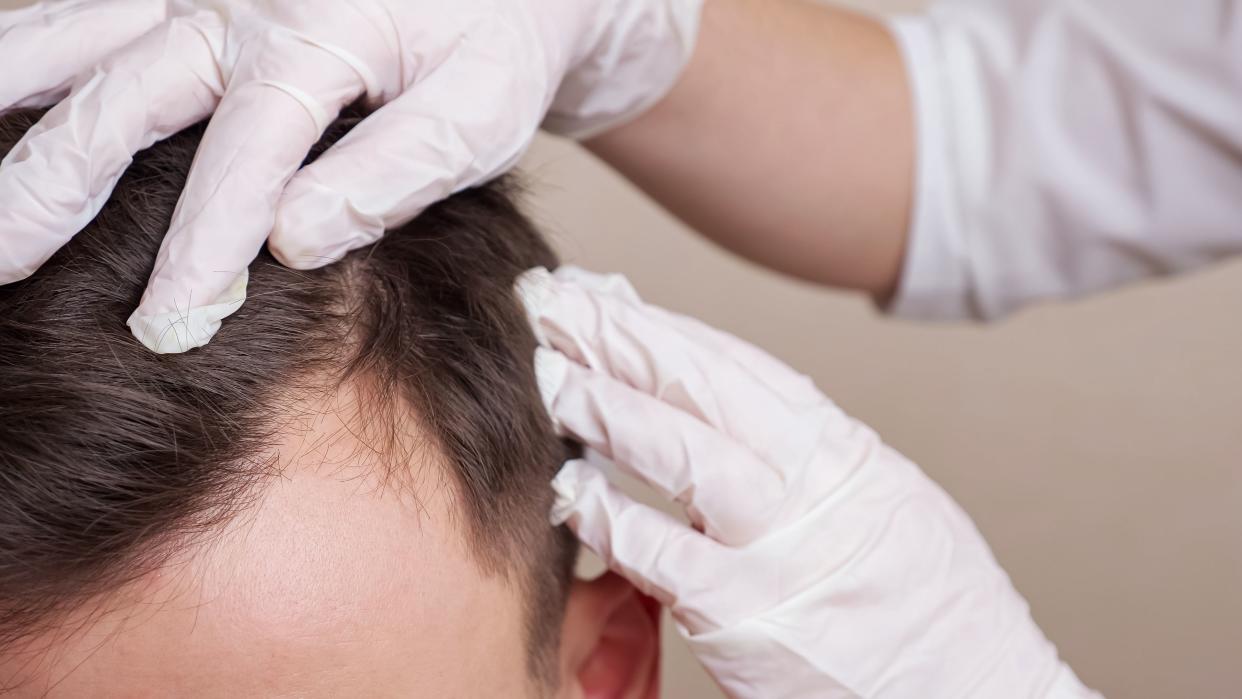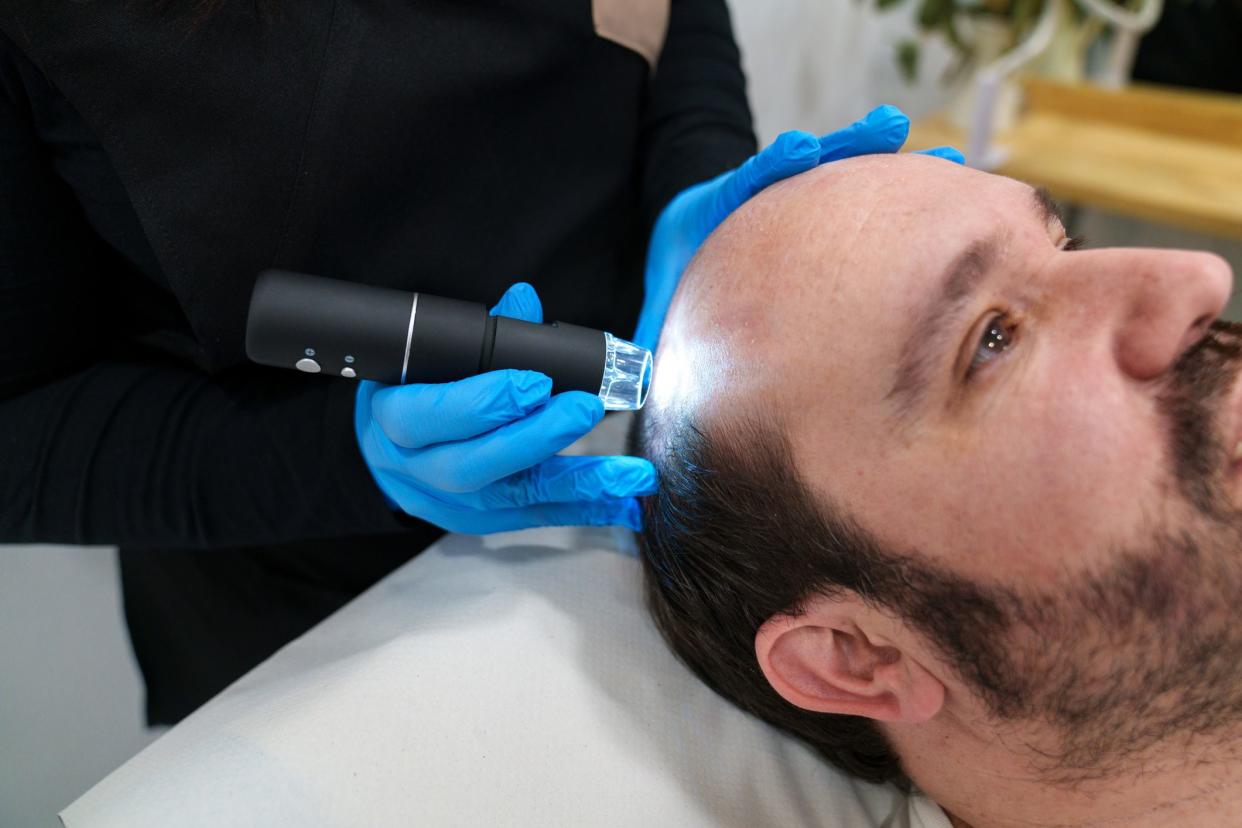Alopecia Universalis
This article was reviewed by Knox Beasley, MD
Alopecia universalis (AU) is a rare autoimmune condition that involves complete loss of hair on your face, scalp, and body. The earlier you seek treatment, the better your chances of maintaining your existing hair and potentially experiencing some regrowth of your scalp, face, or body hair.
What Is Alopecia Universalis?
Alopecia universalis (AU) is a rare, severe form of alopecia areata that leads to complete loss of hair on your face, scalp, and body. It can be challenging to treat, but there are options that can help you maintain your hair and enjoy a higher quality of life.
Below, we’ll explain the symptoms, risk factors, causes, diagnosis process, and treatment of alopecia universalis — including new treatment options such as Janus kinase (JAK) inhibitors. We’ll also discuss some tips that could help you prevent full-body alopecia universalis from getting out of control.

What Are the Symptoms of Alopecia Universalis?
Common symptoms of alopecia areata and universal alopecia include:
-
Sudden hair loss in round or oval-shaped patches
-
Conjoined patches of hair loss that form larger bald spots
-
Hair that grows back white or gray before regaining its natural color
-
Development of ridges and pits in the nails
-
Hair loss that has a smooth appearance without irritation or inflammation
Alopecia universalis symptoms specifically include:
-
Loss of all body hair (including eyelashes, eyebrows, and pubic hair) and scalp hair.

Alopecia Universalis Causes
At the moment, researchers aren’t aware of precisely why alopecia universalis and other forms of alopecia areata develop.
Some people wonder, are you born with alopecia? In very rare cases, alopecia universalis can develop before birth, a condition referred to as alopecia universalis congenita.
As far as alopecia universalis you aren’t exactly born with, experts have identified various factors that may contribute to its development. These include:
-
Genetic factors. Research from studies of twins and families suggests that there’s a large genetic component to alopecia totalis (hair loss across the entire scalp) and alopecia universalis, with people more likely to develop this condition if they have a family history of autoimmune hair loss. Experts have even identified specific genes within the human leukocyte antigen (HLA) complex that may contribute to an elevated risk of autoimmune hair loss. However, many people living with the disease do not have a family history. According to the National Alopecia Areata Foundation, your risk of alopecia areata increased even more if you have a family member who got it before the age of 30.
-
Environmental factors. A range of environmental factors — including chronic or severe stress, infections, illnesses, and certain medications — might also be involved in alopecia areata, alopecia totalis, and alopecia universalis.
If you’re worried your family history or lifestyle choices could lead to this form of complete hair loss, here are two things to keep in mind: Alopecia universalis usually begins as alopecia areata (and is sometimes called alopecia areata universalis). Less than 10 percent of all people with alopecia areata go on to develop alopecia totalis, with an even smaller percentage developing more advanced alopecia universalis over time.

Risk Factors for Alopecia Universalis
Certain factors put you at a greater risk of developing alopecia universalis, like:
-
Having other autoimmune conditions. Research has found that alopecia areata is linked to other autoimmune diseases, with people affected by vitiligo, lupus erythematosus, or autoimmune thyroid disease more likely to develop this form of hair loss.
-
Age. Alopecia universalis can develop at any age. However, most people affected by alopecia areata — the less advanced form of this type of hair loss — first notice symptoms such as shedding and patchy hair loss during their 20s or 30s. When it occurs in children under 10, it tends to be more aggressive.
-
Certain allergic conditions. People with a history of certain allergic conditions (also called atopic conditions), such as asthma, atopic dermatitis (eczema), and hay fever, are at an increased risk of developing alopecia universalis.
-
Stress. Severe physical or emotional stress can trigger autoimmune conditions, including alopecia universalis. Stress alone cannot cause the condition, but it may speed up its onset or progression.

Diagnosing Alopecia Universalis
If you think you might have alopecia universalis, it’s important to talk to your healthcare provider or schedule an appointment with a dermatologist as soon as you can.
Generally, during this visit, they’ll examine your hair and nails (potentially with a microscope), ask questions about your family and medical history, perform a biopsy and, if appropriate, suggest medication to help protect your hair from further damage.
They may also do the following:
-
Hair Pull Test. In this procedure, a healthcare provider gently pulls a clump of hair at the root to see how many strands come loose. A hair pull test assesses how much active hair loss you have.
-
Scalp Biopsy. During a scalp biopsy, a small piece of tissue will be removed from your scalp for further inspection under a microscope. This can be used to rule out other conditions that may resemble alopecia universalis, including tinea capitis or temporal triangular alopecia. “Follicular streamers” seen in a scalp biopsy can also indicate alopecia universalis, but they can also be characteristic of other forms of scarring alopecia.

Alopecia Universalis Treatment
Since alopecia universalis causes such extensive hair loss on the scalp, face, and body, it’s often more challenging to treat than other types of alopecia areata.
There’s currently no cure for alopecia universalis. Having said that, several treatments are available to control your immune system, prevent widespread hair loss from becoming more severe, and, in some cases, produce hair regrowth.
Currently, the most effective treatments for alopecia universalis are topical and systemic steroids, immunosuppressive agents, and Janus kinase (JAK) inhibitors.

Topical and Systemic Steroids
Steroids work by restricting activity in your immune system, which can help protect your hair follicles from damage. Your healthcare provider may prescribe a topical corticosteroid you can apply directly to your scalp or an oral steroid you can take to control inflammation.
To stimulate hair growth and help you maintain a full head of hair, your healthcare provider may also provide injections of anti-inflammatory steroid medications, such as triamcinolone.
Systemic steroids can cause side effects, including acne, weight gain, and moon facies (buildup of fat on the sides of your face). In women, steroids can also cause menstrual side effects, such as dysmenorrhea (menstrual cramping).
If steroids aren’t effective, your healthcare provider may suggest using an immunosuppressive agent. This type of medication reduces your body’s immune responses and may help limit loss of scalp hair, but it can increase your risk of contracting certain infections.

Other Medications for Alopecia Universalis
Recently, a new class of medications referred to as Janus kinase inhibitors has proven helpful for many people with alopecia universalis.
These medications also target your immune system, but they’re more selective than older medications for alopecia universalis and typically work by blocking specific messaging pathways involved in your body’s immune response.
JAK inhibitors used to treat alopecia universalis include tofacitinib (Xeljanz), which is approved by the U.S. Food and Drug Administration (FDA) for treating rheumatoid arthritis but often prescribed off-label for those with severe alopecia areata.
Other JAK inhibitors used as a treatment of alopecia areata or alopecia universalis are ruxolitinib (Jakafi), and baricitinib (Olumiant).
Some of these medications are used mainly for other condition like psoriasis or eczema, but research has found them to be effective at treating hair loss associated with alopecia universalis.
Although research on JAK inhibitors and alopecia universalis is limited, some studies have found that JAK inhibitors work well for people with alopecia areata.
For example, in a recent systematic review and meta-analysis published in the journal Frontiers in Pharmacology, researchers concluded that oral JAK inhibitors were “efficacious and generally well tolerated” as treatments for alopecia areata.
If you have alopecia universalis, it’s essential to work closely with your healthcare provider and follow their instructions, particularly regarding medication.

How to Cope With Alopecia Universalis
Since alopecia universalis often involves extensive hair loss, it can be difficult to deal with on a mental and emotional level. And since finding the right treatment isn’t always easy, making some habitual changes may make it easier to cope with your hair loss and maintain a high quality of life.
Some people with alopecia universalis opt to wear a wig. Wearing a wig might make it easier to maintain the appearance you’re used to, especially if you’ve recently started taking medication and need to wait several months to see if it’s effective.
You can also speak to a healthcare professional about incorporating hair loss treatments like minoxidil (the active ingredient in Rogaine), which may help with hair regrowth, especially when used with other treatments.
If you feel anxious, stressed, or depressed as a result of hair loss, participating in online therapy, talking to a psychiatry provider, or taking part in an anonymous support group might help you gain more control over your feelings and improve your mental well-being.

Alopecia Universalis Prevention Tips
There’s nothing you can do to completely prevent alopecia universalis, but there are a few steps you can take that may help stop it from getting worse:
-
Manage stress. Stress can exacerbate autoimmune disorders, so practicing stress reduction techniques like yoga, meditation, or breathing exercises may help prevent alopecia universalis.
-
Avoid triggers. Protect your scalp and body from potential triggers like direct sunlight and the harsh chemicals often found in chemical relaxers, perms, and straighteners.
-
Practice healthy habits. While they’re not directly related to alopecia universalis, things like eating a balanced diet (with nutrients that support healthy hair, like zinc, iron, and vitamin D), exercising regularly, and sleeping well can help support overall immune health.
-
Act early. It’s a good idea to seek treatment as soon as you notice patchy hair loss or small bald patches. Starting medication early can help prevent it from getting worse.
Related: How to Keep Your Confidence When Losing Your Hair
Related: How to Get Rid of Bald Spots
This article originally appeared on Hims.com and was syndicated by MediaFeed.org






